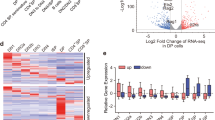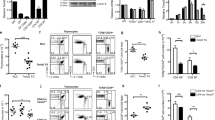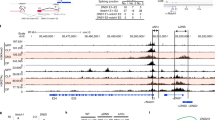Abstract
The CD4 versus CD8 lineage specification of thymocytes is linked to coreceptor expression. The transcription factor MAZR has been identified as an important regulator of Cd8 expression. Here we show that variegated CD8 expression by loss of Cd8 enhancers was reverted in MAZR-deficient mice, which confirms that MAZR negatively regulates the Cd8 loci during the transition to the double-positive (DP) stage. Moreover, loss of MAZR led to partial redirection of major histocompatibility complex (MHC) class I–restricted thymocytes into CD4+ helper-like T cells, which correlated with derepression of Th-POK, a central transcription factor for helper-lineage development. MAZR bound the silencer of the gene encoding Th-POK, which indicated direct regulation of this locus by MAZR. Thus, MAZR is part of the transcription factor network that regulates the CD8 lineage differentiation of DP thymocytes.
This is a preview of subscription content, access via your institution
Access options
Subscribe to this journal
Receive 12 print issues and online access
$209.00 per year
only $17.42 per issue
Buy this article
- Purchase on Springer Link
- Instant access to full article PDF
Prices may be subject to local taxes which are calculated during checkout







Similar content being viewed by others
References
Bosselut, R. CD4/CD8-lineage differentiation in the thymus: from nuclear effectors to membrane signals. Nat. Rev. Immunol. 4, 529–540 (2004).
He, X. & Kappes, D.J. CD4/CD8 lineage commitment: light at the end of the tunnel? Curr. Opin. Immunol. 18, 135–142 (2006).
Singer, A., Adoro, S. & Park, J.H. Lineage fate and intense debate: myths, models and mechanisms of CD4- versus CD8-lineage choice. Nat. Rev. Immunol. 8, 788–801 (2008).
Ellmeier, W., Sawada, S. & Littman, D.R. The regulation of CD4 and CD8 coreceptor gene expression during T cell development. Annu. Rev. Immunol. 17, 523–554 (1999).
Kioussis, D. & Ellmeier, W. Chromatin and CD4, CD8A and CD8B gene expression during thymic differentiation. Nat. Rev. Immunol. 2, 909–919 (2002).
Ellmeier, W., Sunshine, M.J., Maschek, R. & Littman, D.R. Combined deletion of CD8 locus cis-regulatory elements affects initiation but not maintenance of CD8 expression. Immunity 16, 623–634 (2002).
Garefalaki, A. et al. Variegated expression of CD8α resulting from in situ deletion of regulatory sequences. Immunity 16, 635–647 (2002).
Feik, N. et al. Functional and molecular analysis of the double-positive stage-specific CD8 enhancer E8III during thymocyte development. J. Immunol. 174, 1513–1524 (2005).
Bilic, I. et al. Negative regulation of CD8 expression via Cd8 enhancer-mediated recruitment of the zinc finger protein MAZR. Nat. Immunol. 7, 392–400 (2006).
Taniuchi, I., Ellmeier, W. & Littman, D.R. The CD4/CD8 lineage choice: new insights into epigenetic regulation during T cell development. Adv. Immunol. 83, 55–89 (2004).
Bilic, I. & Ellmeier, W. The role of BTB domain-containing zinc finger proteins in T cell development and function. Immunol. Lett. 108, 1–9 (2007).
Kelly, K.F. & Daniel, J.M. POZ for effect–POZ-ZF transcription factors in cancer and development. Trends Cell Biol. 16, 578–587 (2006).
Kobayashi, A. et al. A combinatorial code for gene expression generated by transcription factor Bach2 and MAZR (MAZ-related factor) through the BTB/POZ domain. Mol. Cell. Biol. 20, 1733–1746 (2000).
Fedele, M. et al. PATZ1 gene has a critical role in the spermatogenesis and testicular tumours. J. Pathol. 215, 39–47 (2008).
He, X. et al. The zinc finger transcription factor Th-POK regulates CD4 versus CD8 T-cell lineage commitment. Nature 433, 826–833 (2005).
Sun, G. et al. The zinc finger protein cKrox directs CD4 lineage differentiation during intrathymic T cell positive selection. Nat. Immunol. 6, 373–381 (2005).
Barnden, M.J., Allison, J., Heath, W.R. & Carbone, F.R. Defective TCR expression in transgenic mice constructed using cDNA-based α- and β-chain genes under the control of heterologous regulatory elements. Immunol. Cell Biol. 76, 34–40 (1998).
Hogquist, K.A. et al. T cell receptor antagonist peptides induce positive selection. Cell 76, 17–27 (1994).
Taniuchi, I. et al. Differential requirements for Runx proteins in CD4 repression and epigenetic silencing during T lymphocyte development. Cell 111, 621–633 (2002).
Setoguchi, R. et al. Repression of the transcription factor Th-POK by Runx complexes in cytotoxic T cell development. Science 319, 822–825 (2008).
Egawa, T. & Littman, D.R. ThPOK acts late in specification of the helper T cell lineage and suppresses Runx-mediated commitment to the cytotoxic T cell lineage. Nat. Immunol. 9, 1131–1139 (2008).
Wang, L. et al. Distinct functions for the transcription factors GATA-3 and ThPOK during intrathymic differentiation of CD4+ T cells. Nat. Immunol. 9, 1122–1130 (2008).
Aliahmad, P. & Kaye, J. Development of all CD4 T lineages requires nuclear factor TOX. J. Exp. Med. 205, 245–256 (2008).
Egawa, T., Tillman, R.E., Naoe, Y., Taniuchi, I. & Littman, D.R. The role of the Runx transcription factors in thymocyte differentiation and in homeostasis of naive T cells. J. Exp. Med. 204, 1945–1957 (2007).
Muroi, S. et al. Cascading suppression of transcriptional silencers by ThPOK seals helper T cell fate. Nat. Immunol. 9, 1113–1121 (2008).
He, X. et al. CD4–CD8 lineage commitment is regulated by a silencer element at the ThPOK transcription-factor locus. Immunity 28, 346–358 (2008).
Jepsen, K. & Rosenfeld, M.G. Biological roles and mechanistic actions of co-repressor complexes. J. Cell Sci. 115, 689–698 (2002).
Taniuchi, I. Transcriptional regulation in helper versus cytotoxic-lineage decision. Curr. Opin. Immunol. 21, 127–132 (2009).
Collins, A., Littman, D.R. & Taniuchi, I. RUNX proteins in transcription factor networks that regulate T-cell lineage choice. Nat. Rev. Immunol. 9, 106–115 (2009).
Egawa, T. Runx and ThPOK: A balancing act to regulate thymocyte lineage commitment. J. Cell. Biochem. 107, 1037–1045 (2009).
Wang, L. et al. The zinc finger transcription factor Zbtb7b represses CD8-lineage gene expression in peripheral CD4+ T cells. Immunity 29, 876–887 (2008).
Jenkinson, S.R. et al. Expression of the transcription factor cKrox in peripheral CD8 T cells reveals substantial postthymic plasticity in CD4–CD8 lineage differentiation. J. Exp. Med. 204, 267–272 (2007).
Zou, Y.R. et al. Epigenetic silencing of CD4 in T cells committed to the cytotoxic lineage. Nat. Genet. 29, 332–336 (2001).
Leung, R.K. et al. Deletion of the CD4 silencer element supports a stochastic mechanism of thymocyte lineage commitment. Nat. Immunol. 2, 1167–1173 (2001).
Liu, X. & Bosselut, R. Duration of TCR signaling controls CD4–CD8 lineage differentiation in vivo. Nat. Immunol. 5, 280–288 (2004).
Naoe, Y. et al. Repression of interleukin-4 in T helper type 1 cells by Runx/Cbfβ binding to the Il4 silencer. J. Exp. Med. 204, 1749–1755 (2007).
Acknowledgements
We thank M. Sibilia (Medical University of Vienna) for OT-I TCR-transgenic mice; D. Stoiber-Sakaguchi (Medical University of Vienna) for OT-II TCR-transgenic mice; W. Held (Glaxo) for recombinant human interleukin 2; J. Kaye for information about primer sequences that detect Tox expression; M. Willheim and G. Hofbauer for cell sorting; H. Tanaka for technical advice; E. Pfeiffer for help with irradiation; M. Busslinger for help with some animal experiments; D. Stoiber-Sakaguchi, J. Raberger and N. Boucheron for critical reading of the manuscript; and the National Institutes of Health Tetramer facility for CD1d reagents with and without PBS57. Supported by the Austrian Science Fund (P16708 and P19930), the START Program of the Austrian Ministry of Science and Research (project Y-163), the RIKEN Research Center for Allergy and Immunology (International Collaboration Program) and the Ernst Schering Foundation (M.H.).
Author information
Authors and Affiliations
Contributions
S.S. designed the research, did most of the experiments, analyzed the data and wrote the manuscript; M.H. did coimmunoprecipitation and ChIP assays; A.S. and Y.N. did ChIP assays; I.B. contributed to the generation of Mazr-deficient mice and did some of the bone marrow–transplantation experiments; I.T. provided reagents and experimental mice and contributed to the design of the research; and W.E. designed the research, contributed to the generation of Mazr-deficient mice, analyzed the data and wrote the manuscript.
Corresponding author
Ethics declarations
Competing interests
The authors declare no competing financial interests.
Supplementary information
Supplementary Text and Figures
Supplementary Figures 1–11 and Supplementary Table 1 (PDF 3065 kb)
Rights and permissions
About this article
Cite this article
Sakaguchi, S., Hombauer, M., Bilic, I. et al. The zinc-finger protein MAZR is part of the transcription factor network that controls the CD4 versus CD8 lineage fate of double-positive thymocytes. Nat Immunol 11, 442–448 (2010). https://doi.org/10.1038/ni.1860
Received:
Accepted:
Published:
Issue Date:
DOI: https://doi.org/10.1038/ni.1860
This article is cited by
-
Conversion of effector CD4+ T cells to a CD8+ MHC II-recognizing lineage
Cellular & Molecular Immunology (2021)
-
Twist2 promotes CD8+ T-cell differentiation by repressing ThPOK expression
Cell Death & Differentiation (2020)
-
The zinc-finger transcription factor MAZR regulates iNKT cell subset differentiation
Cellular and Molecular Life Sciences (2019)
-
Priming of lineage-specifying genes by Bcl11b is required for lineage choice in post-selection thymocytes
Nature Communications (2017)
-
PATZ1 is a target of miR-29b that is induced by Ha-Ras oncogene in rat thyroid cells
Scientific Reports (2016)



